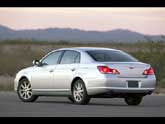Recent Articles
Popular Makes
Body Types
2005 Toyota Avalon Road Test
Building a better Buick
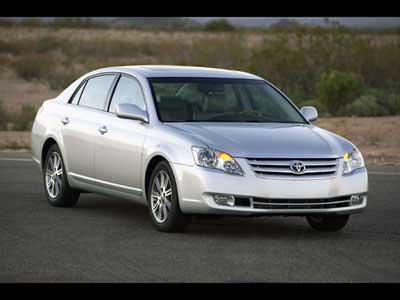
While sitting around my parents’ dinner table on a recent visit, the subject of a replacement for their ten-year-old Buick Riviera came up. The first car that came to mind was the new 2005 Toyota Avalon. From there, the conversation went something like this: But that’s one of those Japanese cars. Actually, it was designed in California, engineered in Michigan, and it’s built in Kentucky. Technically, that makes it more American than some American cars that are built in Mexico or Canada. But the money still goes back to Japan. Maybe some of it does, but the bulk of it supports hard-working men and women right here in the U.S. But I don’t like those Japanese cars… What’s not to like? It’s good-looking, roomy, comfortable, safe, fuel efficient, and reliable enough that it’ll likely be the last car you’ll ever have to buy… Debates about its nationality aside, we came away from our recent week with behind the wheel of the Toyota Avalon convinced it may very well be the best full-size American sedan currently on the market.
Major Changes
When it was introduced in 1995, the Avalon was the first credible attempt by a mainstream Japanese automaker to go toe-to-toe with American car companies in the full-size sedan category. With its redesign in 2000, the Avalon got larger, more comfortable, and more competitive with the best Detroit had to offer. Now, this third-generation Avalon builds on these attributes while addressing its two principal weaknesses – relatively bland styling and few differences between it and the automaker’s best-selling Camry sedans.
Designers started by making this new Avalon bigger in just about every measure. The wheelbase has grown by four inches, the overall length by more than five inches, and the width by over an inch. The car’s once unexceptional exterior has also been replaced by stylish sheet metal with a distinctively upscale look. Besides being bigger and better-looking, the new Avalon is also a good bit more powerful thanks to an all-new 3.5-liter V6 engine and five-speed automatic transmission combo that give it performance equal to any of its competitors. Decent fuel economy and extremely low emissions are the icing on this new powertrain’s cake.
Taken together, these changes go a long way toward bringing the Avalon out of the Camry’s shadow, and may well help it achieve the widespread success that has eluded it over the past decade.
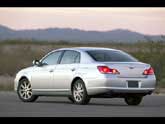
Model Mix
Along with all the changes noted above come two new models designed to further broaden the Avalon’s appeal. To the previous generation’s base XL and upscale XLS trim levels, Toyota product planners have added the sport-oriented Touring and the luxurious Limited versions.
Both new models are pleasant surprises. The Touring model, which slots between the XL and the XLS and features a slightly firmer “sport-tuned” suspension, takes all the great things about the Avalon and wraps them in a more youthful-looking package that will appeal to drivers who may have liked the Avalon’s room and comfort but found its driving character too sedate.
The top-of-the-line Limited, on the other hand, stretches the upper end of the Avalon’s envelope into luxury territory dominated by upscale manufacturers such as Acura, Cadillac, Infiniti, and Lexus. The lack of one of those high-end brands’ logos on the trunk lid or grille may put some luxury buyers off, but the fact is the Avalon Limited will go toe-to-toe with any entry-level luxury model these premium brands have to offer.
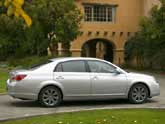
Design
Like any extreme makeover, the folks at Toyota’s West Coast design center in Newport Beach, Calif., have sculpted a dramatic new skin that makes a clean break with the past. Gone are the milquetoast looks and any hint that the Avalon is just a super-sized Camry.
The car’s increased dimensions, combined with its relatively long hood and short rear deck, greater proportion of sheet metal to side glass, and black window pillars and frames make the car look longer and more substantial. The vertical body-colored grille with chrome accents, sharp drop-off from the trunk lid to the back bumper, and standard alloy wheels also give the Avalon a more elegant appearance similar to the $70,000 Audi A8L, one of the best-looking sedans on the street.
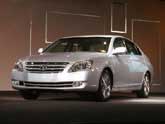
Interior
Inside, the 2005 Toyota Avalon’s design is just as attractive as the outside. Generous use of leather and soft-touch plastics, accented by faux, brushed aluminum and some of the best fake wood trim we’ve laid eyes on gave our Limited a very upscale look and feel.Aesthetics aside, we especially applaud the designers’ efforts to make an interior with a fair number of bells-and-whistles look clean and uncluttered. The lack of the usual confusing jumble of buttons, joysticks, and knobs makes this a lesson in user-friendly interfaces we’d like to see product designers everywhere take to heart.
This ergonomic streamlining begins with audio system controls housed behind a panel that opens and closes smoothly with a touch of a finger. Controls for the dual-zone climate control, navigation system, and trip computer are similarly hidden away in a panel that lowers from a space just below the audio system and ahead of the console-mounted shift lever.
The controls that remain exposed are among the best we’ve used. Classy Optitron gauges and the center-mounted, seven-inch color LCD display are bright and easy to read. The translucent buttons flanking the audio system cover are large and substantial, making it easy to find the setting you’re looking for with a quick glance. Another nice touch is the subdued backlighting that makes these buttons every bit as easy to use at night. The leather and wood-trimmed steering wheel also includes audio and climate control buttons, though the main controls were so user-friendly we rarely felt the need to use the auxiliary features.
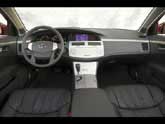
Comfort
Within the 2005 Toyota Avalon’s true five-passenger interior you’ll find large and supportive front seats designed to accommodate a wide range of body sizes and shapes. Longer seat tracks and a tilt/telescope steering column allow taller drivers to stretch out and shorter drivers to sit a safe distance from the airbag. One curious oversight is the lack of power-adjustable accelerator and brake pedals, even as an option.
Our Avalon Limited’s power driver and front passenger seats were covered in soft perforated leather and included seat heaters to take the chill off on cold mornings and fans in the seat bottom and back to keep you cool on hot afternoons. Other welcome touches include power lumbar support and an electric bottom cushion length adjustment to help drivers find the ideal level of thigh support.
The subdued noise levels of our Limited test car’s cabin provided the kind of comfort perfect for day-long drives. There’s little wind or road noise to intrude, though the interior doesn’t quite match the cocoon-like quality that is the trademark of vehicles from the automaker’s Lexus brand.
The Avalon’s cockpit is a driver-friendly place. The biggest fault, in fact, is that the cover for the audio system refused to stay latched shut and, when it did stay closed, proved hard to open again. A small matter easily rectified under warranty, perhaps, but it stood out in light of the overall high standards we’ve come to expect from Toyota products. Move to the back seat and you’ll find the passenger compartment almost as accommodating as it is up front. Topping the rear seat’s list of strong points are long rear doors that swing wide to make getting in and out a breeze.
Once inside you’ll find enough width to install three car seats – or even three good-sized adults. Generous legroom and the flat floor means there’s plenty of room for all to stretch out. There’s even a power rear sunshade that will allow you to keep the sun’s rays off your passengers’ delicate noggins with the touch of a dash-mounted button.
The backseat’s neatest trick, however, are the levers on the lower edge of the outboard seats that recline the seatbacks up to ten degrees. While that may not sound like much, it means the difference between someplace you’d settle for on the way to lunch with your co-workers and a premium space you’d agree to ride in all day without hesitation. Even the center position, the weakest link of most back seats, provides a good perch with plenty of padding and generous foot room courtesy of that flat floor and the recessed aft edge of the center console. If only there were seat heaters and a DVD entertainment system back here, we’d gladly let somebody else drive everywhere.
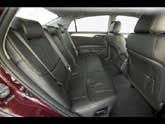
Cubbies & Cargo
The 2005 Toyota Avalon’s interior design team saw to it that there were plenty of places to stow that odds-‘n-ends that accumulate in daily driving.
Along with a generously-sized storage compartment with a 12-volt power outlet underneath the nicely padded sliding center armrest, there’s another slightly smaller cubby (also with a 12-volt power outlet) located on the center console. Twin cupholders, two tip-out pockets in each front door, and a sunglasses holder in the overhead console round out the list of storage options. In back, flip down the center armrest and you’ll find dual cupholders and a shallow compartment as well as pockets in both rear doors.
The good-sized trunk is big enough to accommodate luggage for a family of four that hasn’t learned the meaning of packing light. A pass-through opening located behind the rear seat’s center armrest, which enables the trunk to accommodate longer cargo, is standard on all models.
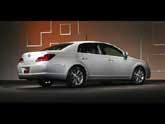
Powertrain
Engineers have imbued the Avalon with impressive acceleration thanks to a new 280-horsepower, 3.5-liter V6 engine. With roughly 30 percent more power than the previous generation and significantly more oomph than its V6-powered competition, the motor has the punch to make short work of freeway on-ramps and passing slower traffic on your favorite two-lane stretch of country road.
One downside, especially in these days of skyrocketing pump prices, is the cost associated with running the engine’s recommended 91-octane premium fuel (it will run on regular, but not optimally). The V6 makes fairly good use of this precious commodity however, returning respectable EPA fuel economy estimates of 22 mpg in the city and 31 mpg on the highway.
A five-speed automatic is the only transmission offered, and it’s a good one with smooth, sure gear changes. The transmission’s manual shift feature works well, but seems unnecessary on a car built more for comfort than for speed.
Despite the move to rear- or all-wheel drive by several of its top competitors, Toyota has chosen to stick with the familiar front-wheel-drive system. While we’re sure we could find folks willing to debate the wisdom of this decision, we think the inherent advantages of front-wheel drive makes this the sensible way to go for the majority of buyers.
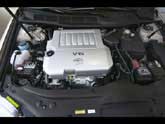
Test Drive
Full-size sedans are about pampering passengers, and the 2005 Toyota Avalon’s fully independent suspension excels in this important consideration. On the road, the Avalon’s standard set-up delivers a highly refined ride quality, nicely smoothing out minor pavement imperfections without leaving the driver feeling disconnected from the road.
Handling – long the Achilles’ heel of full-size American sedans – is surprisingly capable given the car’s size and cushy orientation. The Avalon’s suspension does allow a noticeable amount of body roll, but the car feels sure-footed and predictable enough in turns that there’s no sense of taking your life in your hands in a fast corner.
If you enjoy a bit of spirited driving now and again, you’ll appreciate the slightly firmer suspension at the heart of the Touring model. It’s no European sports sedan, but it is a good bit more rewarding for those of us for whom driving is about more than just getting from Point A to B.
Effort for the power-assisted rack-and-pinion steering is light and reasonably precise, much as you’d expect from a mainstream luxury car. Given our more sporting tastes, we’d like to see both qualities dialed up a bit, but we never felt like there was any problem getting and keeping the car pointed in the right direction.
When it came time to bring this 3,600-pound machine to a halt, the Avalon’s four-wheel-disc brakes delivered no-nonsense stops every time. ABS is standard on all Avalon models.
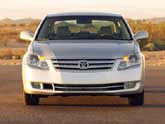
Safety
Just as impressive as all the things you can see and feel about the redesigned 2005 Toyota Avalon is the long list of standard safety features you’ll hopefully never have to use. All models include multi-stage front airbags that match their force to the severity of the crash as well as a special knee airbag for the driver.
New, larger, torso-protecting side-impact airbags for the driver and front seat passenger are standard on all models, as are side-curtain airbags that extend the length of the cabin to shield the heads of all outboard occupants in side collisions and rollover accidents. Daytime running lights and three-point seatbelts at all five seating positions round out the list of passive safety features.
Electronic stability control, a system that uses sensors to detect and stop an impending skid before it occurs, is an option on XLS and Limited models. While the $650 price tag may sound steep, results of a recent government study have confirmed our belief that this must-have safety feature is well worth the cost.
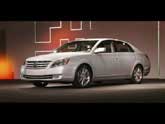
Wrap-up and Specs
In the final measure, whether you see the Toyota Avalon as an American car or a Japanese car that just happens to be made in America doesn’t really matter. When you take one for a test drive, we figure it’ll impress you so much you simply won’t care. SPECIFICATIONS: Test Vehicle: 2005 Toyota Avalon Touring Price of Test Vehicle: $37,594 Engine Size and Type: 3.5-liter V6 Engine Horsepower: 280 at 6,200 rpm (using premium fuel) Engine Torque: 260 at 4,700 rpm (using premium fuel) Transmission: Five-speed automatic with manual-shift feature Drive Wheels: Front-wheel drive Curb weight, lbs.: 3,600 EPA Fuel Economy (city/highway): 22/31 Length: 197.2 inches Width: 72.8 inches Wheelbase: 111.0 inches Height: 58.5 inches Legroom (f/r): 41.3/40.9 Headroom (f/r): 38.8/37.5 Max. Seating Capacity: 5 Max. Cargo Volume: 14.4 cu. ft.
Photos courtesy of Toyota Motor Sales, U.S.A
